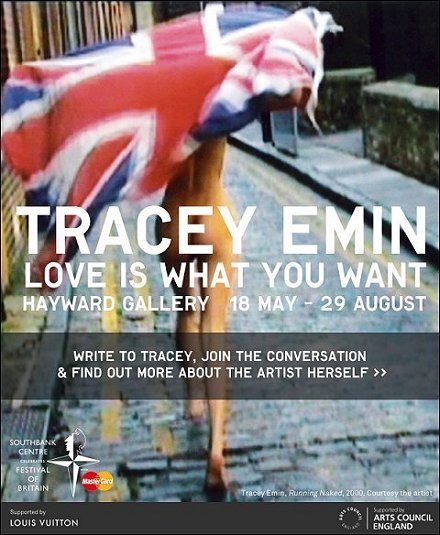Tracey Emin: Love is what you want

Hayward Gallery London
TRACEY EMIN
Love is what you want
until August 29, 2011
Tracey Emin is one of Britain’s most celebrated contemporary artists. This major survey exhibition covers every period of her career, revealing facets of the artist and her work that are often overlooked. The exhibition features painting, drawing, photography, textiles, video and sculpture, in works that are by turns tough, romantic, desperate, angry, funny and full of longing. Seldom-seen early works and recent large-scale installations are shown together with a new series of outdoor sculptures created especially for the Hayward Gallery.

Since the early 1990s, Emin (b.1963) has used her own life as the starting point for her art, exposing the most harrowing and intimate details of her personal history. Sometimes confrontational or sexually provocative, her work resonates with the ‘personal political’ legacy of feminist art while at the same time speaking to relationships in general. Disarmingly frank and yet often profoundly private, much of Emin’s art – as this show makes clear – is also animated by her playful and ironic wit.
This show features works containing explicit images and words. Under-16s must be accompanied by an adult.
BLANKETS
Tracey Emin’s large appliquéd blankets overflow with words and phrases and are collaged from fabrics that have special meaning for her. The complex arrangement of applied letters and inscriptions has analogies with news design, with headlines and patches of handwritten texts spread across the work like print on a newspaper page. Reminiscent of banners paraded in religious, civic and political processions, Emin’s blankets contain many different voices, with topics ranging from incidents in her own life to concerns with events in the wider world.
NEONS
Tracey Emin uses neon to illuminate emotions, memories, feelings and ideas in graphic messages, sentences and poems. While neon has its seedy connotations, Emin finds it sexy: ‘It’s spangly, it’s pulsating. It’s out there, it’s vibrant.’ Translating handwriting and drawings into blown and bent neon tubing presents technical challenges,and the choice of words or images is crucial: ‘Not everything warrants being made in neon. It has to be specific. Neon is light, so, can you live with this thing glowing and the chemicals moving all the time?’
FILMS
Tracey Emin’s narratives and fantasies sometimes find their most appropriate expression in film. Mostly made in low-tech formats, their content veers from tragedy to comedy, from candid documentary to absurd flights of fancy. In How It Feels (1996) she recounts the details of a botched abortion and its physical and emotional aftermath, while in Love is a Strange Thing she is propositioned by a drooling dog. Her home town of Margate, and Cyprus, where her father is from, are locations for other short films about rites of passage in which music plays a prominent part.
MEMORABILIA
Tracey Emin’s family and friends are celebrated in many of her works. They often feature in assemblages that combine objects and ephemera along with handwritten texts. These narratives speak directly about their subjects – her maternal grandmother, her father – and the relics displayed. The earliest of them formed a ‘Wall of Memorabilia’ in her first solo exhibition, My Major Retrospective, in 1993. In 2003, Emin returned to using memorabilia in her art. Her exhibition Menphis featured framed ephemera and text memorialising different moments in her life, from childhood to adulthood.
DRAWINGS
Tracey Emin’s drawings are the mainstay of her art. They are in fact monoprints, a technique which involves drawing in reverse, through the back of the paper. Emin likes it ‘because you never know what the print’s going to be like when you turn it over.’ Her characteristic graphic line finds its expression in almost every medium she uses, including needlework. She explains that ‘through my embroideries, the line I draw is accentuated and extreme, which complements the way that I think.’
PAINTINGS
Tracey Emin describes her intimate, small-scale paintings as both ‘pretty and hard-core’. Though the subject is the artist herself, these more or less abstracted, often faceless images portray states of mind rather than physical likenesses. Admitting that she confronts herself with ‘apprehension and fear’, Emin goes on to say: ‘I try to detach myself from what I’m looking at, but at the same time I know exactly what I’m looking at. I’m looking at me in the most intimate way, which I don’t really want to look at or really think about, but try to come to terms with.’
SCULPTURE
‘I want to make sculptures that look like they’ve just landed,’ Tracey Emin has said. ‘Something conjured from my imagination.’ She makes sculpture in many media, but has a special affection for wooden structures: ‘Wood can be really grand, but it can also be small and intimate. Wood can be weathered, it’s got a history.’ Knowing My Enemy (2002), a partially-collapsed pier with a hut at its end, pays homage to her father. Other sculptures in the exhibition reflect the everyday tensions of love, or evoke disparate, dysfunctional families.
WRITING
Tracey Emin has said that writing is the backbone of everything she does. ‘I’m not known as a text-based artist, but I should be really,’ she points out. ‘It’s my words that actually make my art quite unique.’ Lettering and handwritten texts take centre stage in her blankets, neons and memorabilia works and act as voiceovers in her graphic art, while spoken narratives are a feature of her films and videos. A published author and newspaper columnist, Emin makes direct and powerful statements and observations, tells stories, plays with language, and writes poems and love letters.
Southbank Centre/Hayward Gallery London
TRACEY EMIN
Love is what you want
≡ Website southbank centre Hayward Gallery
fleursdumal.nl magazine
More in: Exhibition Archive, FDM in London, Sculpture

